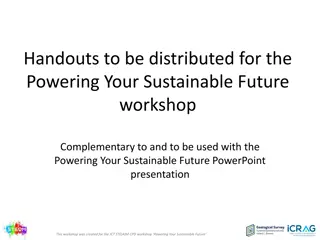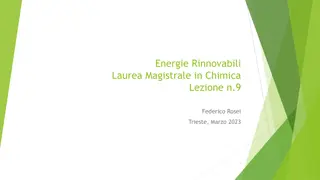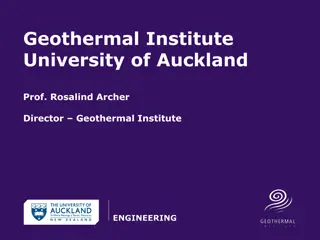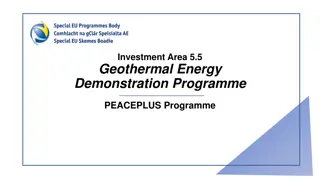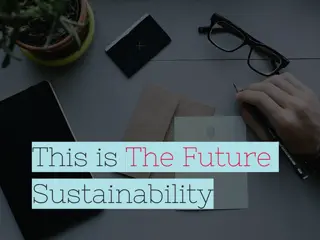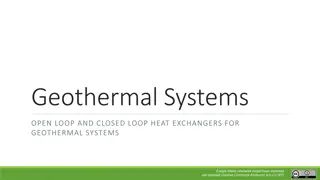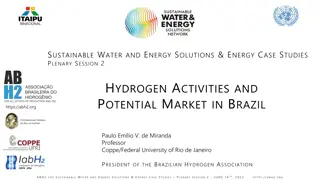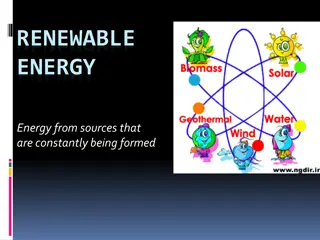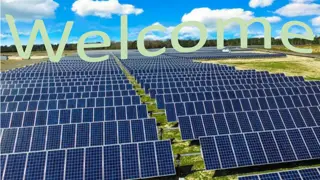Geothermal Energy: Sources and Applications
Geothermal energy is harnessed from Earth's internal heat sources, such as radioactive decay and residual heat. Different geothermal energy sources include hot water reservoirs, natural steam reservoirs, and geopressured reservoirs. This renewable energy is utilized for space heating, air conditioning, industrial processes, and electricity generation. Direct uses involve pumping water underground to absorb heat, while generating electricity requires temperatures above 150°C. Explore the potential of geothermal energy for sustainable power generation and direct applications.
Download Presentation

Please find below an Image/Link to download the presentation.
The content on the website is provided AS IS for your information and personal use only. It may not be sold, licensed, or shared on other websites without obtaining consent from the author.If you encounter any issues during the download, it is possible that the publisher has removed the file from their server.
You are allowed to download the files provided on this website for personal or commercial use, subject to the condition that they are used lawfully. All files are the property of their respective owners.
The content on the website is provided AS IS for your information and personal use only. It may not be sold, licensed, or shared on other websites without obtaining consent from the author.
E N D
Presentation Transcript
Sources of Earths Internal Energy 70% comes from the decay of radioactive nuclei with long half lives that are embedded within the Earth Some energy is from residual heat left over from Earths formation. The rest of the energy comes from meteorite impacts.
Different Geothermal Energy Sources Hot Water Reservoirs: As the name implies these are reservoirs of hot underground water. There is a large amount of them in the US, but they are more suited for space heating than for electricity production. Natural Stem Reservoirs: In this case a hole dug into the ground can cause steam to come to the surface. This type of resource is rare in the US. Geopressured Reservoirs: In this type of reserve, brine completely saturated with natural gas in stored under pressure from the weight of overlying rock. This type of resource can be used for both heat and for natural gas.
Normal Geothermal Gradient: At any place on the planet, there is a normal temperature gradient of +300C per km dug into the earth. Therefore, if one digs 20,000 feet the temperature will be about 1900C above the surface temperature. This difference will be enough to produce electricity. However, no useful and economical technology has been developed to extracted this large source of energy. Hot Dry Rock: This type of condition exists in 5% of the US. It is similar to Normal Geothermal Gradient, but the gradient is 400C/km dug underground. Molten Magma: No technology exists to tap into the heat reserves stored in magma. The best sources for this in the US are in Alaska and Hawaii.
Direct uses of geothermal energy is appropriate for sources below 1500C space heating air conditioning industrial processes drying Greenhouses Aguaculture hot water resorts and pools melting snow
How Direct Uses Work Direct Sources function by sending water down a well to be heated by the Earth s warmth. Then a heat pump is used to take the heat from the underground water to the substance that heats the house. Then after the water it is cooled is injected back into the Earth.
Generation of Electricity is appropriate for sources >150oC Dry Steam Plants: These were the first type of plants created. They use underground steam to directly turn the turbines.
Flash Steam Plants: These are the most common plants. These systems pull deep, high pressured hot water that reaches temperatures of 3600F or more to the surface. This water is transported to low pressure chambers, and the resulting steam drives the turbines. The remaining water and steam are then injected back into the source from which they were taken.
Binary Cycle Plants: This system passes moderately hot geothermal water past a liquid, usually an organic fluid, that has a lower boiling point. The resulting steam from the organic liquid drives the turbines. This process does not produce any emissions and the water temperature needed for the water is lower than that needed in the Flash Steam Plants (2500F 3600F). Casa Diablo
Hot Dry Rocks: The simplest models have one injection well and two production wells. Pressurized cold water is sent down the injection well where the hot rocks heat the water up. Then pressurized water of temperatures greater than 2000F is brought to the surface and passed near a liquid with a lower boiling temperature, such as an organic liquid like butane. The ensuing steam turns the turbines. Then, the cool water is again injected to be heated. This system does not produce any emissions. US geothermal industries are making plans to commercialize this new technology.
Geothermals Harmful Effects Brine can salinate soil if the water is not injected back into the reserve after the heat is extracted. Extracting large amounts of water can cause land subsidence, and this can lead to an increase in seismic activity. To prevented this the cooled water must be injected back into the reserve in order to keep the water pressure constant underground. Power plants that do not inject the cooled water back into the ground can release H2S, the rotten eggs gas. This gas can cause problems if large quantities escape because inhaling too much is fatal.
One well blew its top 10 years after it was built, and this threw hundreds of tons of rock, mud and steam into the atmosphere. There is the fear of noise pollution during the drilling of wells.
Geothermals Positive Attributes Useful minerals, such as zinc and silica, can be extracted from underground water. Geothermal energy is homegrown. This will create jobs, a better global trading position and less reliance on oil producing countries. US geothermal companies have signed $6 billion worth of contracts to build plants in foreign countries in the past couple of years. In large plants the cost is 4-8 cents per kilowatt hour. This cost is almost competitive with conventional energy sources.
Geothermal plants can be online 100%-90% of the time. Coal plants can only be online 75% of the time and nuclear plants can only be online 65% of the time. Flash and Dry Steam Power Plants emit 1000x to 2000x less carbon dioxide than fossil fuel plants, no nitrogen oxides and little SO2. Geothermal electric plants production in 13.380 g of Carbon dioxide per kWh, whereas the CO2 emissions are 453 g/kWh for natural gas, 906g g/kWh for oil and 1042 g/kWh for coal. Binary and Hot Dry Rock plants have no gaseous emission at all. Geothermal plants do not require a lot of land, 400m2 can produce a gigawatt of energy over 30 years.
Geothermal Heat Pumps: - produces 4 times the energy that they consume. -initially costs more to install, but its maintenance cost is 1/3 of the cost for a typical conventional heating system and it decreases electric bill. This means that geothermal space heating will save the consumer money. -can be installed with the help of special programs that offer low interest rate loans. Electricity generated by geothermal plants saves 83.3 million barrels of fuel each year from being burned world wide. This prevents 40.2 million tons of CO2 from being emitted into the atmosphere. Direct use of geothermal energy prevents 103.6 million barrels of fuel each year from being burned world wide. This stops 49.6 tons of CO2 from being emitted into the atmosphere.
Availability of Geothermal Energy On average, the Earth emits 1/16 W/m2. However, this number can be much higher in areas such as regions near volcanoes, hot springs and fumaroles. As a rough rule, 1 km3 of hot rock cooled by 1000C will yield 30 MW of electricity over thirty years. It is estimated that the world could produce 600,000 EJ over 5 million years. There is believed to be enough heat radiating from the center of the Earth to fulfill human energy demands for the remainder of the biosphere s lifetime.
Geothermal production of energy is 3rd highest among renewable energies. It is behind hydro and biomass, but before solar and wind. Iceland is one of the more countries successful in using geothermal energy: -86% of their space heating uses geothermal energy. -16% of their electricity generation uses geothermal energy.






